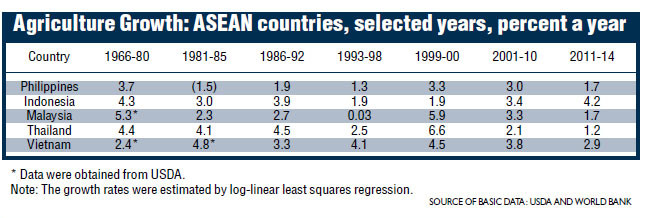Economic and agriculture scores of Philippine presidents
Confucius said: “Study the past if you would define the future.”
Now that the election is over, it is time to take stock of who is the true performer in growing the Philippine economy and agriculture. Theodore Roosevelt said: “The more you know about the past, the better prepared you are for the future.”
A Nov. 15, 2015 article (not in this paper) by noted UP School of Economics professor Dr. Emmanuel de Dios titled “The truth about the economy under the Marcos regime” observed:
“… The average GDP growth rate from 1972 to 1985 (Marcos’ last full year) was all of 3.4 percent per annum. Per-capita GDP grew annually at less than one percent average over the period— more precisely 0.82 percent. Hardly a roaring-tiger performance. For comparison, the average GDP growth from 2003 to 2014—even under a bumbling and quarrelsome democracy—has been 5.4 percent per annum—with a rising trend. On a per capita basis, GDP today is rising 3.5 percent annually, more than four times the growth rate under Marcos.”
“The reason for the dismal performance under martial law is well-understood. The economy suffered its worst post-war recession under the Marcos regime because of the huge debt hole it had dug from which it could not get out.”
This article will provide another perspective to the debate. It will look into the economic and agriculture performances under the various political periods. We can classify 1966 to 2014 into seven periods: Marcos I, Marcos II, Corazon Aquino, Fidel Ramos, Joseph Estrada, Gloria Arroyo and Benigno Aquino III.
Caveat: concerns have been expressed by referees on at least two aspects: (a) the period lengths are not comparable, and (b) no analysis on spillover effects on preceding administration on the succeeding one. But since the main objective of this article is to compare political periods, I will leave it to the analytical economists to address these concerns to conform to academic rigor.
GDP growth
The Marcos I period (1966-80) was one of rapid growth. The Philippines grew at a notable 5.5 percent a year. But Marcos II (1981-85) posted the depressed record at negative 2.5 percent a year. It was followed by the Corazon Aquino period (1986-1992) which had to struggle in the transition with 3.5 percent a year as well as coups. The putsch leaders are still around.
Meanwhile, the Ramos era faced the Asian financial crises and the most severe drought of the century. The Arroyo period (2001-2010) posted good performance at 4.9 percent a year. The fastest growth was under the Benigno Aquino years (2011-2014) at 6.5 percent a year.
Compared to Asean peers, all the past presidents fell short, except Benigno Aquino. Indonesia, Malaysia, Thailand and Vietnam achieved growth rates some 2 percentage points faster.
Agriculture growth
Philippine agriculture posted the slowest expansion in the Asean in the last 50 years. The fastest and slowest growth were registered during the Marcos years. Marcos I (1966-80) did well at 3.7 percent a year but behind Malaysia, Thailand and Indonesia. It was also the period driven by the Asia-wide Green Revolution and infrastructure development.
But Marcos II (1981-85) posted a sluggish performance with a negative growth of 1.5 percent a year. The short-lived Estrada (1999-2000) and Arroyo years (2001-2010) made significant strides, but still short of the Asean average. The Ramos period (1993-1998) registered the second slowest growth, but Asean countries did not do as well due to the 1997-1998 El Nino episode. The Benigno Aquino years (2011-2014) had the slowest advance since 1999. Under-investment in agriculture affected the Corazon Aquino and Ramos years while the latter also suffered from a major El Niño event in 1997-1998.
Agriculture productivity growth
How did the Philippines fare over the past 50 years? It has the poorest record in farm productivity. It posted only 1.3 percent a year growth versus the better performers: Malaysia 2.6 percent a year and Vietnam 1.9 percent a year. The fastest productivity growth occurred during Marcos I, Estrada and Arroyo times. Declines were posted in Marcos II and Ramos periods. The latter suffered a big setback due to the El Niño of 1997-1998.
Compared to Asean, the Marcos I period was above par. The other times were all below average. The trailblazers were Malaysia and Vietnam.
First, GDP growth was behind the Asean peers since 1965, except during the Benigno Aquino period, which posted the highest Philippine GDP growth since 1965. It was also the highest in the Asean. The next best performers were Marcos I (1966-80) and Arroyo (2001-2010). Marcos II period (1981-85) had the poorest performance.
Second, agriculture growth over the past 50 years trailed behind Asean peers. The best and the worst years were Marcos I and Marcos II. Benigno Aquino’s record was behind that of Arroyo.
Third, Philippine agriculture productivity growth was slowest in the Asean. Its best years were under the Marcos I, Estrada and Arroyo years. The lagging performers were Marcos II, Ramos and Benigno Aquino.
(The article reflects the personal opinion of the author and does not reflect the official stand of the Management Association of the Philippines or MAP. The author is the Vice Chair of the MAP AgriBusiness and Countryside Development Committee, and the Executive Director of the Center for Food and AgriBusiness of the University of Asia & the Pacific. Feedback at <map@map.org.ph> and <rdyster@gmail.com>. For previous articles, please visit <map.org.ph>)



